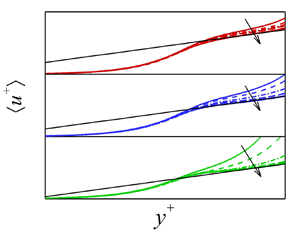Article contents
Maximum drag enhancement asymptote in spanwise-rotating viscoelastic plane Couette flow of dilute polymeric solutions
Published online by Cambridge University Press: 01 March 2023
Abstract

The existence of a maximum drag enhancement (MDE) asymptote at high rotation ( $Ro$) and Weissenberg (
$Ro$) and Weissenberg ( $Wi$) numbers in turbulent viscoelastic spanwise-rotating plane Couette flow has been demonstrated. Specifically, it is shown that above a critical
$Wi$) numbers in turbulent viscoelastic spanwise-rotating plane Couette flow has been demonstrated. Specifically, it is shown that above a critical  $Wi$, drag enhancement plateaus and the MDE asymptote is realized in a broad range of
$Wi$, drag enhancement plateaus and the MDE asymptote is realized in a broad range of  $Ro$. The mean velocity profiles at MDE appear to closely follow a log-law profile that has a nearly identical slope but different intercepts as a function of
$Ro$. The mean velocity profiles at MDE appear to closely follow a log-law profile that has a nearly identical slope but different intercepts as a function of  $Ro$. Much like the maximum drag reduction (MDR) asymptote, the logarithmic function in MDE is closely followed if the mean velocity is plotted using the traditional inner variable scaling; however, the logarithmic function is not well defined when examined by the indicator function. Hence, in this study, we have used the logarithmic fit as a visual guide for the mean velocity profile. Last and perhaps the most intriguing finding of this study is that MDE occurs in the elasto-inertial turbulence (EIT) flow state; hence, it is mainly sustained by elastic forces much like the MDR flow state. To that end, a universal picture of elastically induced drag modification asymptotes is emerging, namely these asymptotic states are an inherent property of the elastically sustained EIT flow state.
$Ro$. Much like the maximum drag reduction (MDR) asymptote, the logarithmic function in MDE is closely followed if the mean velocity is plotted using the traditional inner variable scaling; however, the logarithmic function is not well defined when examined by the indicator function. Hence, in this study, we have used the logarithmic fit as a visual guide for the mean velocity profile. Last and perhaps the most intriguing finding of this study is that MDE occurs in the elasto-inertial turbulence (EIT) flow state; hence, it is mainly sustained by elastic forces much like the MDR flow state. To that end, a universal picture of elastically induced drag modification asymptotes is emerging, namely these asymptotic states are an inherent property of the elastically sustained EIT flow state.
JFM classification
Information
- Type
- JFM Papers
- Information
- Copyright
- © The Author(s), 2023. Published by Cambridge University Press
References
REFERENCES
- 6
- Cited by


